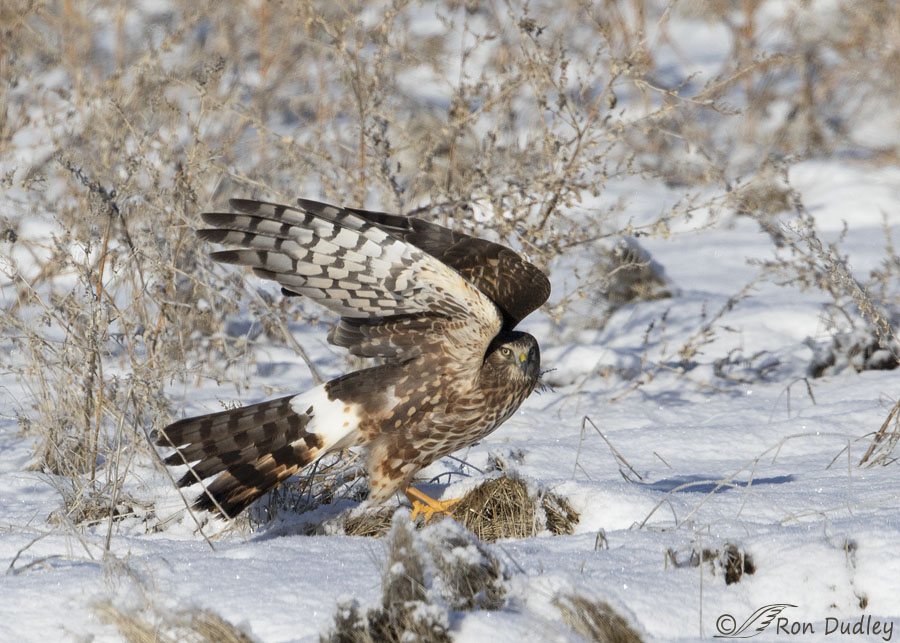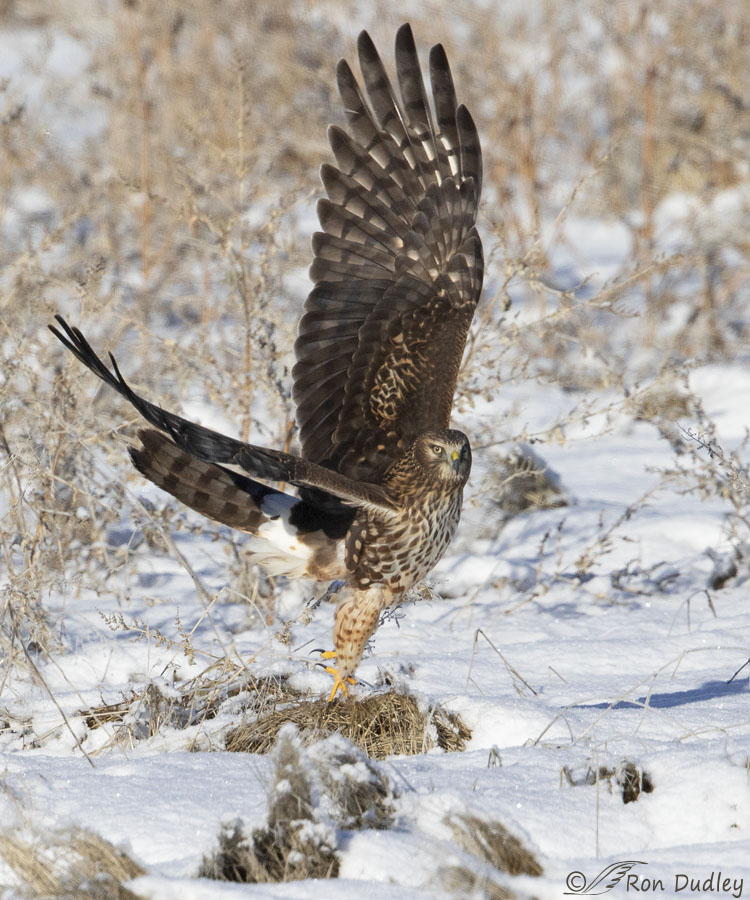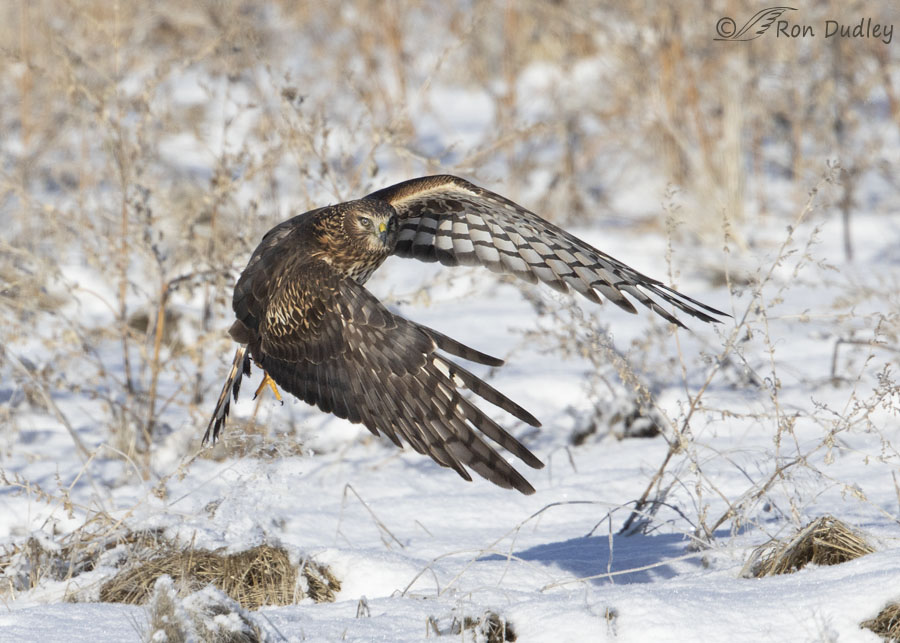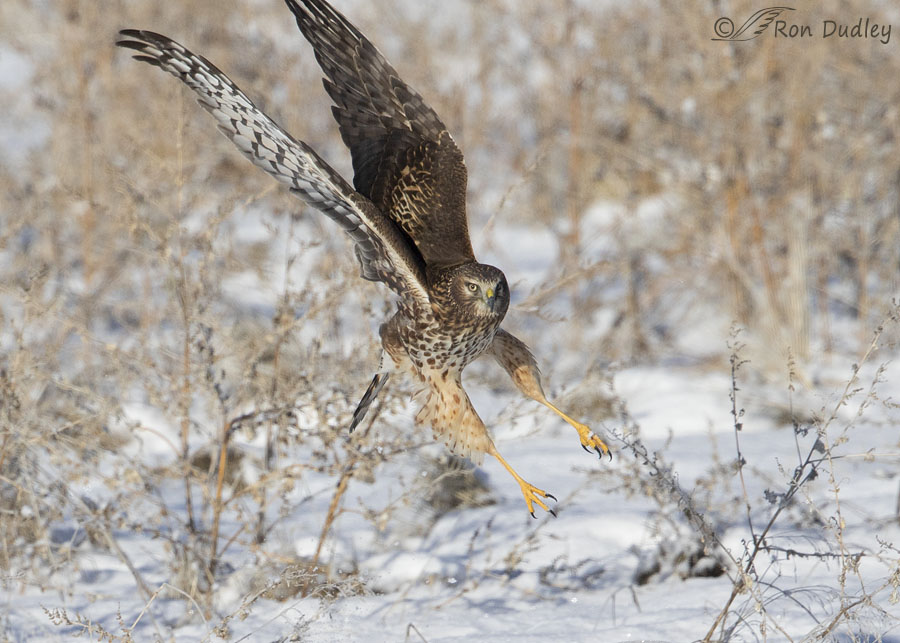Normally I try to avoid posting photos of the same species to my blog on consecutive days but this series, taken yesterday morning at Farmington Bay WMA, called for an exception.
The following four photos are consecutive shots in a burst without any skips.

1/6400, f/7.1, ISO 500, Canon 7D Mark II, Canon EF 500mm f/4L IS II USM + EF 1.4 III Extender, not baited, set up or called in
While perched the hawk was just a little too far away for quality photos so all I could hope for was takeoff and flight shots. Thankfully the bird cooperated.

1/6400, f/7.1, ISO 500, Canon 7D Mark II, Canon EF 500mm f/4L IS II USM + EF 1.4 III Extender, not baited, set up or called in
I love this takeoff posture with direct eye contact thrown in as a bonus.
I’m always amazed at the incredible coordination of various body parts required during takeoff. Here she has already pushed off with her legs and both of her wings and her tail are in perfect position to perform their function of providing additional lift. Both wings have been elevated for their first downbeat and the unfanned tail has been raised for the same purpose. The downstroke of the wings will provide most of the lift off of the perch but the tail in this raised position will be instantly fanned out and brought down quickly to provide additional lift. Many of us don’t think of the tail “flapping” to provide lift during takeoff but it does, especially with larger raptors.
In addition her intention is to begin turning my way during takeoff thus the asymmetrical position of her wings at this point in the process.

1/5000, f/7.1, ISO 500, Canon 7D Mark II, Canon EF 500mm f/4L IS II USM + EF 1.4 III Extender, not baited, set up or called in
When combined with the momentum provided by the push-off with her legs the downbeat of both wings and her now flared tail popped her light body a foot off the perch in a single downstroke.
A pretty impressive maneuver if you ask me.
1/6400, f/7.1, ISO 500, Canon 7D Mark II, Canon EF 500mm f/4L IS II USM + EF 1.4 III Extender, not baited, set up or called in
I was bummed to have clipped a wing in the next shot in the series. I’m including it because I like how her body has been thrown to our right as it hangs from her wings during the sharp turn. After this shot she completed the 180° turn and flew off to our left but I lost focus on her because it’s so difficult for me to follow a bird in flight while shooting from my pickup window at that angle behind me.
In the comments to yesterday’s post blog follower Steven Holt discussed the unusually light wing loading of Northern Harriers (“wing loading = the total weight of the bird divided by the surface area of its wings”). Please go back and look at the second photo again and notice all the surface area in that incredibly long and wide left wing.
The light wing loading of harriers helps to explain this quick and “easy” liftoff and the ability of harriers to fly at unusually slow speeds while they “harry” potential prey directly beneath them.
As Steven mentioned in his comment yesterday, harriers are “mostly feathers and air”.
Ron
Note: For the sake of comparison – Red-tailed Hawks have a wingspan of 49″ while the wingspan of Northern Harriers is 43″. However, red-tails are more than 2 1/2 times heavier than harriers (1080g versus 420g). Statistics from Sibley.



SPECTACULAR!
Charlotte
Beautiful series Ron. You captured this lovely raptor so wonderfully!!!
Thanks very much, Pamela.
That second one is one heck of a yoga pose. All are wonderful shots.
Thank you, Jane.
Holy cow! These are something else! Her legs look especially long and spindly in the last shot. I adore the second shot — she looks like she’s just starting a grande jete — amazing!!!
Marty, those very long legs are unbelievably quick in fights with other harriers. They fire them out at their opponent in lightning quick jabs like spears with four talons on the end. Here’s an example (third photo):
https://www.featheredphotography.com/blog/2017/11/17/fighting-northern-harriers-plus-a-rant-about-baiting-raptors/
I remember that post — those legs are brutal and effective.
These are incredible shots, Ron!!!!! I LOVE that the Northern Harrier has been featured a lot lately- it’s my favorite!!! No complaints here 🙂
Thanks very much, Emily. A favorite of mine too, as evidenced by the vanity plates on my pickup.
Haha!!! Love it!!! 🙂
Absolutely wonderful series of photos, Ron. The Harrier is my favorite hawk. So stern and regal. And the length of those feathers is amazing.
“the length of those feathers is amazing”
Yes, I notice that particularly in the tail in the first shot of the series.
Awe and wonder.
Which is a most excellent start to the day (when I finally got the PC to boot up).
Many, many thanks.
And in other news we finally got a little rain 0.3inches (and hail) and other areas got more.
Thanks, EC. Just a little is better than none at all. Hope it continues.
Wonderful series, Ron!
Thanks, Kathleen.
Fabulous series. The light is perfect, the eye is perfect and looking directly at you, and the snow is an added bonus. I think the snowy background really enhances the photos as opposed to the normal dry background that somewhat matches the Harriers colors. Great photos. As I have said before, if they were mine they would be framed and hanging somewhere. 🙂
Oh, and Ron, you can do Harriers for a solid week and I would not be bored.
Ha, that’s good to know, Everett. Just by the nature of bird photography I often have the most success with a single species over multiple days running.
Gorgeous Harrier and take off photos! 🙂 Also interesting on the “mostly feathers and air”…… It amazes me the prey they can deal with given their size. 🙂 Guaranteed “something” is going to get “cut off” with the speed of the action – I’d be lucky to get one decent photo out of the series! 😉 A successful morning shooting “kinda” makes up for it.. 😉
Thank you, Judy. Actually, it was far from a successful morning of bird photography. I visited two widely separated locations (Antelope Island and Farmington) and these four harrier photos were the only decent ones I got.
Beautiful series! I am always awestruck when looking at photos that exhibit the wingspan and photos like your second shot…the length is something you just don’t fathom when you see them on the ground. What wonderful little ‘flying machines’ they are! 😍 Don’t mind Harriers two days in a row at all.
“the length is something you just don’t fathom when you see them on the ground”
Boy that’s for sure. Even when they’re flying their wings are often less than fully extended so we still don’t appreciate it. But at this (2nd Photo) exact moment of takeoff it sure is impressive. Thanks, Kathy.